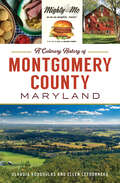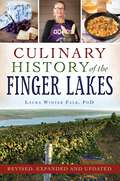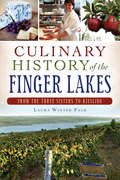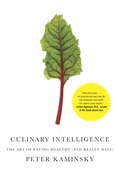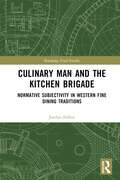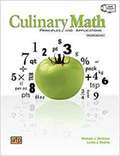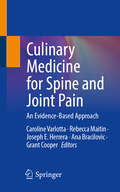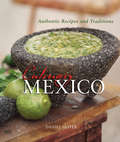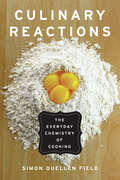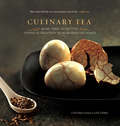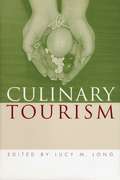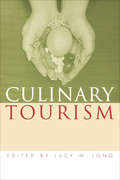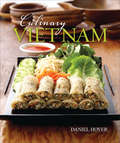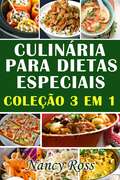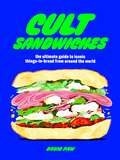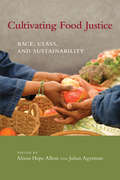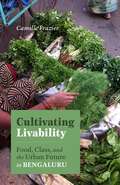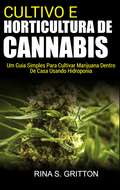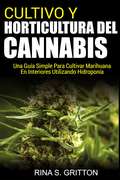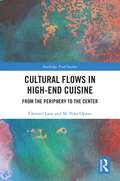- Table View
- List View
Culinary History of Downeast Maine, A (American Palate)
by Sharon L. JoyceMaine’s Downeast culinary history begins well before explorers arrived in the 1500s. Some of the food preparation and preservation techniques used by the Wabanakis and early colonists are still in use today. Lobster and other seafood from the Gulf of Maine and the area now known as Acadia National Park paved the way for a vibrant tourist food scene. The “rusticators� like the Rockefellers, Pulitzers, Astors, Vanderbilts and other wealthy families created a mixed environment of fashionable food trends and simple foods like fish chowder. Locals like the 40 Hayseeders used food as a statement to make fun of the “summer people.� Author Sharon Joyce details the rich and delicious history of food in Downeast Maine.
Culinary History of Montgomery County, Maryland, A (American Palate)
by Claudia Kousoulas Ellen LetourneauMontgomery County's Agricultural Reserve, created in 1980, was a history-making decision that is a model for land preservation.Montgomery County's earliest residents, Native Americans, developed agricultural communities and used the shores of the Potomac as a trading spot. European settlers farmed tobacco, eventually collapsing the County's economy until the Quaker community returned fertility to the land. The C&O Canal was the nation's first significant infrastructure project and helped create links to national and international markets. In the 20th century, the Marriott chain developed contemporary, industrialized food that signaled a changing world. The Agricultural Reserve was intended to preserve the county's rural past in the face of rapid change. Along with farming, it also preserved history and foodways. Claudia Kousoulas and Ellen Letourneau tell this agricultural history through food and recipes.
Culinary History of the Finger Lakes (American Palate)
by Dr Laura Winter FalkThis popular history, recipe and wine pairing book has been fully revised, enhanced and updated. Dive deeper into the traditional cooking and culture of the Haudenosaunee—the first people of the Finger Lakes region. Learn how this unique region was once teeming with salmon and why they no longer breed here. Uncover the speakeasy culture that prospered during Prohibition. Local author, sommelier and educator Laura Winter Falk reveals new regional chefs and their creative takes on period recipes, as well as the tremendous growth in the area’s wine and craft beverages movement. With more excellent producers, restaurants and markets committed to showcasing the bounty of the region, there has never been a better time to discover the unique flavor of the Finger Lakes.
Culinary History of the Finger Lakes: From the Three Sisters to Riesling (American Palate)
by Laura Winter FalkA bounty of crisp apples, heirloom produce, artisan cheeses and grass-fed meats complement the heady libations of the Finger Lakes wine country. Culinary luminaries and home cooks alike use these regional ingredients to craft classic and unique dishes, like Moosewood's apple spice cake. Finger Lakes foodie and vinophile Laura Winter Falk, PhD, explores the Finger Lakes' gustatory legacy and evolution, from the Iroquois' Three Sisters--corn, squash and beans--to the farm-to-table restaurants that celebrate the harvest of their neighbors. With recipes from regional chefs paired perfectly with an array of local wines, savor the delectable culinary history of New York's Finger Lakes region.
Culinary Intelligence
by Peter KaminskyFor many of us the idea of healthy eating equals bland food, calorie counting, and general joylessness. Or we see the task of great cooking for ourselves as a complicated and expensive luxury beyond our means or ability. Now Peter Kaminsky--who has written cookbooks with four-star chefs (for example, Daniel Boulud) and no-star chefs (such as football legend John Madden)--shows us that anyone can learn to eat food that is absolutely delicious and doesn't give you a permanently creeping waistline. Just a couple years ago, Kaminsky found himself facing a tough choice: lose weight or suffer the consequences. For twenty years, he had been living the life of a hedonistic food and outdoors writer, an endless and luxurious feast. Predictably, obesity and the very real prospect of diabetes followed. Things had to change. But how could he manage to get healthy without giving up the things that made life so pleasurable? In Culinary Intelligence, Kaminsky tells how he lost thirty-five pounds and kept them off by thinking more--not less--about food, and he shows us how to eat in a healthy way without sacrificing the fun and pleasure in food.Culinary Intelligence shows us how we can do this in everyday life: thinking before eating, choosing good ingredients, understanding how flavor works, and making the effort to cook. Kaminsky tells us what we need to give up (most fast food and all junk food) and what we can enjoy in moderation (dessert and booze), but he also shows us how to tantalize our tastebuds by maximizing flavor per calorie, and he makes delectably clear that if we eat delicious, flavorful foods, we'll find ourselves satisfied with smaller portions while still enjoying one of life's great pleasures.
Culinary Landmarks
by Elizabeth DriverCulinary Landmarks is a definitive history and bibliography of Canadian cookbooks from the beginning, when La cuisinière bourgeoise was published in Quebec City in 1825, to the mid-twentieth century. Over the course of more than ten years Elizabeth Driver researched every cookbook published within the borders of present-day Canada, whether a locally authored text or a Canadian edition of a foreign work. Every type of recipe collection is included, from trade publishers' bestsellers and advertising cookbooks, to home economics textbooks and fund-raisers from church women's groups.The entries for over 2,200 individual titles are arranged chronologically by their province or territory of publication, revealing cooking and dining customs in each part of the country over 125 years. Full bibliographical descriptions of first and subsequent editions are augmented by author biographies and corporate histories of the food producers and kitchen-equipment manufacturers, who often published the books. Driver's excellent general introduction sets out the evolution of the cookbook genre in Canada, while brief introductions for each province identify regional differences in developments and trends. Four indexes and a 'Chronology of Canadian Cookbook History' provide other points of access to the wealth of material in this impressive reference book.
Culinary Man and the Kitchen Brigade: Normative Subjectivity in Western Fine Dining Traditions (Routledge Food Studies)
by Jordan FallonCulinary Man and the Kitchen Brigade offers an exploration of the field of normative subjectivity circulated within western fine dining traditions, presenting a theoretical analysis of the governing relationship between the chef, who embodies the Culinary Man, and the fine dining brigade.The book offers a unique treatment of western haute cuisine’s interlocking regime of labor and aesthetics and theorizes the underexplored kitchen brigade as a model of disciplinary formation. It deploys a heterogeneous set of disciplinary discourses and practices which have the effect of consolidating monopolies on epistemic authority and governance. Each position within the brigade’s hierarchy is subject to distinct, though related, disciplinary practices. Thus, chapters identify the specific practices pertinent to each brigade subject, while also illuminating how they fit together as a coherent hegemonic project. The application of Wynterian and Foucauldian insight to the fine dining brigade offers a political theory of culinary work which departs from other food studies texts. Notably, this work offers an in-depth treatment of the brigade’s colonial dimensions which resonate with emerging critiques, scholarly and general, of the race and gender politics of restaurant labor. The concluding chapters seek to identify where extant modes of resistance or alternative forms of culinary organization may hold the potential to move beyond the hegemonic overrepresentation of Culinary Man.This book will be of great interest to students and scholars from across the social sciences and humanities interested in critical food studies, political and cultural theory, and popular culinary culture.
Culinary Math: Principles And Applications
by Michael J. Mcgreal Linda J. PadillaCulinary Math Principles and Applications" demonstrates how and why foodservice workers use math in the professional kitchen. This popular text-workbook helps learners grasp culinary math principles and applications through an engaging and well-illustrated style. Interactive learner resources provide opportunities for reinforcement and further examples of math used in culinary settings. This educational resource can serve as a basis for college culinary math, foodservice math, and hospitality math courses.
Culinary Medicine for Spine and Joint Pain: An Evidence-Based Approach
by Grant Cooper Joseph E. Herrera Ana Bracilovic Caroline Varlotta Rebecca MaitinCulinary Medicine is a field of growing interest and importance. Medical doctors are increasingly aware that they have not received adequate training in this field in medical school, residency or fellowship, and patients frequently ask their doctors about appropriate diets for spine and joint conditions. Doctors are often left to &“google&” the question, shrug their shoulders, or send the patients to nutritionists who don&’t have specific training on culinary medicine for spine and joint issues. This unique book provides evidence-based clarity on the questions of what food choices are appropriate for promoting and maintaining a healthy musculoskeletal system. The book opens with the essentials of Culinary Medicine, an overview of the anti-inflammatory diet, and the importance of the gut microbiome to overall health and well-being. Subsequent chapters discuss its application to a variety of spine and joint conditions, including degenerative disc disease, spinal stenosis, osteoarthritis, tendinopathies, muscle growth and aerobic workout. Practical pearls are the provided for how to incorporate Culinary Medicine into one's practice.
Culinary Mexico: Authentic Recipes and Traditions
by Daniel HoyerFrom the chef and author of Culinary Vietnam comes a culinary adventure through the vibrant culture, history, and cuisines of Mexico. Mexico&’s rich history and myriad cultural influences are reflected in its food, which exposes a largely unexplored world of nuanced flavors and unique ingredients, as well as a wide range of cooking styles and techniques. Dismiss the old notions of Mexican food as tacos, enchiladas, burritos, and refried beans all smothered in melted cheese. Culinary Mexico presents an extensive collection of surprisingly distinct recipes from the diverse regions of Mexico. The delicious food that has evolved from each region makes a bold statement of what a true Mexican feast can and ought to be.Culinary Mexico presents cuisines from six distinct Mexican regions, from the Northern Frontier, the Pacific Coast, the Isthmus of Tehuantepec, the Central Crossroads, the Colonial Plains and Highlands, and the Yucatán Peninsula. The book also includes complete menus for pairing these unique foods, process photos for cooking, a chapter on techniques, and a resource section. Brimming with full-color photography and interesting lore, this superb cookbook brings you an unexplored world of nuanced flavors, unique ingredients, and all things good of culinary Mexico.
Culinary Reactions: The Everyday Chemistry of Cooking
by Simon Quellen FieldExploring the scientific principles behind everyday recipes, this informative blend of lab book and cookbook reveals that cooks are actually chemists. Following or modifying recipes is shown to be an experiment with acids and bases, emulsions and suspensions, gels and foams. This easy-to-follow primer includes recipes that demonstrate the scientific concepts, such as Whipped Creamsicle Topping (a foam), Cherry Dream Cheese (a protein gel), and Lemonade with Chameleon Eggs (an acid indicator). Also included in this fun, fact-filled companion are answers to various culinary curiosities, such as How does altering the ratio of flour, sugar, yeast, salt, butter, and water affect how high bread rises? and Why is whipped cream made with nitrous oxide rather than the more common carbon dioxide?
Culinary Tea: More Than 150 Recipes Steeped in Tradition from Around the World
by Cynthia GoldThis cutting-edge tome on one of the worldOCOs oldest ingredients and most popular beverages will be an invaluable tool for both home and professional cooks. Gold and Stern offer new ways of looking at tea: the leaves with a history stretching thousands of years is now a secret weapon in the culinary arsenal. Tea in its many forms has been around for thousands of years, and is a burgeoning industry in many countries as the demand for specialty leaves grows. Read all about the picking and drying techniques virtually unchanged for centuries, popular growing regions in the world, and the storied past of trading. "Culinary Tea" has all this, plus more than 100 recipes using everything from garden-variety black teas to exclusive fresh tea leaves and an in-depth treatment of tea cocktails. The book will include classics, such as the centuries-old Chinese Tea-Smoked Duck and Thousand-Year Old Eggs, as well as recipes the authors have developed and collected, such as Smoked Tea-Brined Capon and Assam Shortbread. "
Culinary Tourism
by Lucy M. LongCulinary Tourism is the first book to consider food as both a destination and a means for tourism. The book's contributors examine the many intersections of food, culture and tourism in public and commercial contexts, in private and domestic settings, and around the world. The contributors argue that the sensory experience of eating provides people with a unique means of communication. Editor Lucy Long contends that although the interest in experiencing ""otherness"" is strong within American society, total immersion into the unfamiliar is not always welcome. Thus spicy flavors of Latin Aermcia and the exotic ingredients of Asia have been mainstreamed for everyday consumption. Culinary Tourism explains how and why interest in foreign food is expanding tastes and leading to commercial profit in America, but the book also show how tourism combines personal experiences with cultural and social attitudes toward food and the circumstances for adventurous eating.
Culinary Tourism (Material Worlds)
by Lucy M. Long&“Well-researched and original&” essays on the intersection between food and adventure (Publishers Weekly). Culinary Tourism is the first book to consider food as both a destination and a means for tourism. The book&’s contributors examine the many intersections of food, culture, and tourism in public and commercial contexts, in private and domestic settings, and around the world. The contributors argue that the sensory experience of eating provides people with a unique means of communication—whether they&’re trying out a new kind of ethnic restaurant in their own town or the native cuisine of a place far from home. Editor Lucy Long explains how and why interest in foreign food is expanding tastes and leading to commercial profit in America, but the book also shows how tourism combines personal experiences with cultural and social attitudes toward food and the circumstances that allow for adventurous eating. &“Contributors to the book are widely recognized food experts who encourage readers to venture outside the comforts of home and embark on new eating experiences.&” —Lexington Herald-Leader
Culinary Vietnam
by Daniel HoyerWith the help of the chef and author of Culinary Mexico, explore the tantalizing blend of the fresh, bright, sweet, and hot flavors of Vietnam. Vietnamese cuisine has developed over thousands of years with countless influences from other cultures. Full of authentic recipes, Culinary Vietnam teaches how the aspects of flavor, aroma, texture, color, contrast, balance, and even the sound a food makes should be taken into consideration in the planning of a Vietnamese meal. Author Daniel Hoyer opens the door into the world of Vietnamese cooking methods and theories, as well as to the background of the cuisine, and gives some historical and cultural tidbits, all while showing just the breadth of this simple, agriculturally based cuisine.
Culinária para Dietas Especiais: Coleção 3 em 1
by Nancy RossQuer aprender mais de 100 receitas para dietas especiais com instruções passo a passo? Descubra deliciosas receitas para a dieta cetogênica, mediterrânea e alcalina, tudo em só um livro! Algumas das receitas que você vai encontrar: Barrinhas de café da manhã, pizza, muffins, salada tailandesa, frango mexicano, salada de tomate, macarrão de frutos do mar, polenta com vegetais, mexilhões ao molho de vinho, o melhor bife do mundo, salada de quinoa, bolinhos inegrais, musse de chocolate, cozido de tofu e muitas outras! Mantenha-se na dieta com mais facilidade, aprendedo pratos deliciosos e saudáveis!
Cult Sandwiches: the ultimate guide to iconic things-in-bread from around the world
by David Paw"A beautifully designed tome ... a loving and energetic culinary world tour" - The ObserverFrom New York to Macau and from London to Guadalajara, there is no food more democratic, or currently more coveted, than the sandwich. Part travel inspo and part foodie bible, Cult Sandwiches is the ultimate guide to 100 iconic things-in-bread from around the world. Food writer David Paw delves into the details of specific sandwiches from destination delis and cafés such as Langer's in LA and Er Buchetto in Rome, as well as exploring national icons like Tunisia's fricassé and Japan's ichigo sando.Cult Sandwiches will tell you what and where the most delicious sandwiches are and how they're made, and chews over the origins of mouth-watering classics and the cultural significance of this most humble of meals.
Cult Sandwiches: the ultimate guide to iconic things-in-bread from around the world
by David Paw"A beautifully designed tome ... a loving and energetic culinary world tour" - The ObserverFrom New York to Macau and from London to Guadalajara, there is no food more democratic, or currently more coveted, than the sandwich. Part travel inspo and part foodie bible, Cult Sandwiches is the ultimate guide to 100 iconic things-in-bread from around the world. Food writer David Paw delves into the details of specific sandwiches from destination delis and cafés such as Langer's in LA and Er Buchetto in Rome, as well as exploring national icons like Tunisia's fricassé and Japan's ichigo sando.Cult Sandwiches will tell you what and where the most delicious sandwiches are and how they're made, and chews over the origins of mouth-watering classics and the cultural significance of this most humble of meals.
Cultivating Food Justice
by Julian Agyeman Alison Hope AlkonPopularized by such best-selling authors as Michael Pollan, Barbara Kingsolver, and Eric Schlosser, a growing food movement urges us to support sustainable agriculture by eating fresh food produced on local family farms. But many low-income neighborhoods and communities of color have been systematically deprived of access to healthy and sustainable food. These communities have been actively prevented from producing their own food and often live in "food deserts" where fast food is more common than fresh food. Cultivating Food Justice describes their efforts to envision and create environmentally sustainable and socially just alternatives to the food system. Bringing together insights from studies of environmental justice, sustainable agriculture, critical race theory, and food studies, Cultivating Food Justice highlights the ways race and class inequalities permeate the food system, from production to distribution to consumption. The studies offered in the book explore a range of important issues, including agricultural and land use policies that systematically disadvantage Native American, African American, Latino/a, and Asian American farmers and farmworkers; access problems in both urban and rural areas; efforts to create sustainable local food systems in low-income communities of color; and future directions for the food justice movement. These diverse accounts of the relationships among food, environmentalism, justice, race, and identity will help guide efforts to achieve a just and sustainable agriculture.
Cultivating Food Justice: Race, Class, and Sustainability (Food, Health, and the Environment)
by Julian Agyeman Alison Hope AlkonDocuments how racial and social inequalities are built into our food system, and how communities are creating environmentally sustainable and socially just alternatives.Popularized by such best-selling authors as Michael Pollan, Barbara Kingsolver, and Eric Schlosser, a growing food movement urges us to support sustainable agriculture by eating fresh food produced on local family farms. But many low-income neighborhoods and communities of color have been systematically deprived of access to healthy and sustainable food. These communities have been actively prevented from producing their own food and often live in “food deserts” where fast food is more common than fresh food. Cultivating Food Justice describes their efforts to envision and create environmentally sustainable and socially just alternatives to the food system. Bringing together insights from studies of environmental justice, sustainable agriculture, critical race theory, and food studies, Cultivating Food Justice highlights the ways race and class inequalities permeate the food system, from production to distribution to consumption. The studies offered in the book explore a range of important issues, including agricultural and land use policies that systematically disadvantage Native American, African American, Latino/a, and Asian American farmers and farmworkers; access problems in both urban and rural areas; efforts to create sustainable local food systems in low-income communities of color; and future directions for the food justice movement. These diverse accounts of the relationships among food, environmentalism, justice, race, and identity will help guide efforts to achieve a just and sustainable agriculture.
Cultivating Livability: Food, Class, and the Urban Future in Bengaluru
by Camille FrazierWhat urban food networks reveal about middle class livability in times of transformation In recent years, the concept of &“livability&” has captured the global imagination, influencing discussions about the implications of climate change on human life and inspiring rankings of &“most livable cities&” in popular publications. But what really makes for a livable life, and for whom? Cultivating Livability takes Bengaluru, India, as a case study—a city that is alternately described as India&’s most and least livable megacity, where rapid transformation is undergirded by inequalities evident in the food networks connecting peri-urban farmers and the middle-class public. Anthropologist Camille Frazier probes the meaning of &“livability&” in Bengaluru through ethnographic work among producers and consumers, corporate intermediaries and urban information technology professionals. Examining the varying efforts to reconfigure processes of food production, distribution, retail, and consumption, she reveals how these intersections are often rooted in and exacerbate ongoing forms of disenfranchisement that privilege some lives at the expense of others.
Cultivating Your Microbiome: Ayurvedic and Chinese Practices for a Healthy Gut and a Clear Mind
by Bridgette SheaA holistic guide to improving your gut flora for better physical and emotional health • Explores the influence of the gut microbiome and the mesentery on all other bodily systems, especially the brain and immune system • Explains the central role of the digestive system in Ayurveda and traditional Chinese medicine and how these systems treat the microbiome • Presents herbal remedies, acupuncture and acupressure techniques, and dietary methods to restore balance to your gut flora, including a microbiome reset In traditional medicine, such as Indian Ayurveda and Chinese medicine, the digestive system and microbiome are recognized as the foundation for good health. Our internal flora influences our immune system, brain function, hormonal balance, cravings, sleep, mood, inflammatory response, digestion, nutrient assimilation, and elimination. In this holistic guide to cultivating a healthy microbiome and managing gut health naturally, Bridgette Shea explores digestive functioning from the perspectives of both Western science and traditional medicine. She examines Ayurvedic and Chinese medicine principles on digestion and constitution types. She reveals how, in addition to describing what we now call the microbiome, traditional Chinese medicine also has long recognized the importance of an abdominal organ that modern science has only recently acknowledged: the mesentery, the tissues that connect and support the internal organs. Going beyond probiotics and prebiotics, the author presents practices from Ayurveda and Chinese medicine to reestablish balance in your internal microbiome, support the mesentery, improve digestion and elimination, and restore a clear mind and strong immune system. She explains how to read your symptoms, from brain fog and fatigue to congestion and stool quality, and offers herbal remedies, acupuncture and acupressure techniques, and dietary methods to improve your internal health, including a microbiome dietary reset. Revealing the diverse role that our inner microbial colonies play in keeping us happy and healthy, this book shows that by changing your microbiome, you can greatly improve your physical, emotional, and mental health.
Cultivo e Horticultura de Cannabis: Um Guia Simples Para Cultivar Marijuana Dentro de Casa Usando Hidroponia
by Rina S. GrittonEste é um excelente guia para iniciantes e profissionais no cultivo interno de maconha para uso pessoal usando hidroponia e solo. Ele traz para você as técnicas simples e os métodos que você precisa para ter um santuário próspero para suas plantas de cannabis e produzir plantas com botões potentes e enormes quantidades de resinas! Cultivar a sua cannabis dentro de casa dá-lhe a oportunidade de monitorar o seu crescimento e fazer ajustes nas condições ambientais que irão estimular o crescimento da planta. É também um modo de evitar a pestilência que vem com o cultivo ao ar livre. Tentando ter um conhecimento básico que pode ser aproveitado para cultivar plantas grandes? Então este é o livro para você! As partes envolvidas no cultivo de cannabis são completamente cobertas. Do design e tipo de espaço do santuário ao tipo de nutrientes, à temperatura, controle de pragas ao fluxo de ar; tudo o que você precisa para cultivar cepas de maconha está ao seu alcance. Cada estágio do cultivo, desde a obtenção das sementes até a secagem e a curagem, é totalmente explicado em termos que você pode facilmente entender e colocar em prática imediatamente. Então você quer dar os primeiros passos para nutrir esta bela planta para uma poderosa maravilha da natureza? Este livro vai te ensinar como. Cultive sua cepa enquanto emprega altos padrões de segurança Aprenda como garantir um espaço de crescimento discreto em uma área confinada Tenha a capacidade de determinar a potência do seu produto Floração forçada Aplicando as melhores fórmulas de nutrientes para suas plantas Cruzando e identificando a melhor intensidade para você Obtendo todas as plantas femininas não fertilizadas (Sinsemilla) Controle de Pragas Fazendo o melhor uso da hidroponia E muito mais! Começar com este livro fará de você um cultivador iluminado e apreciador de tudo o que é cannabis e não apenas um produtor. Compre este livro agora e aproveite!
Cultivo y horticultura del cannabis: Una guía simple para cultivar marihuana en interiores utilizando hidropinía
by Rina S. GrittonEsta es una excelente guía para principiantes y profesionales en el cultivo en interiores de marihuana para uso personal utilizando hidroponía y suelo. ¡Le brinda técnicas y métodos simples que necesita para tener un santuario próspero para sus plantas de cannabis y producir plantas con cogollos potentes y cantidades masivas de resinas! Cultivar su cannabis en interiores le brinda la oportunidad de controlar su crecimiento y realizar ajustes en las condiciones ambientales que estimularán significativamente el crecimiento de la planta. También es una vía para prevenir pestes que vienen junto con el cultivo al aire libre. ¿Busca tener un conocimiento básico que se pueda aprovechar para cultivar grandes plantas? ¡Entonces este es el libro para usted! Las partes mayores y menores que participan en el cultivo de cannabis se tratan a fondo. Desde el diseño y el tipo de espacio del santuario hasta el tipo de nutrientes, de la iluminación a la temperatura, del control de plagas al flujo de aire. Todo lo que necesita para cultivar potentes variedades de marihuana está a tu alcance. Cada etapa del cultivo, desde la obtención de las semillas hasta el secado y el curado, se explica completamente en términos que usted puede entender fácilmente y para que pueda poner en práctica de inmediato. Entonces, ¿desea dar los primeros pasos para nutrir esta hermosa planta desde la semilla hasta una potente maravilla de la naturaleza? Este libro le enseñará cómo: Crecer su reserva mientras emplea altos estándares de seguridad Aprender a asegurar un espacio de crecimiento discreto en un área confinada Ser capaz de determinar la potencia de su producto Floración forzada Aplicar las mejores fórmulas de nutrientes a tus plantas Cruza e identificación de la mejor cepa para usted Obtenr todas las plantas femeninas no fertilizadas (sin semilla) Control de plagas Aprovechar al máximo la hidroponía ¡Y mucho más! Comience con este libro y se convertirá e
Cultural Flows in High-End Cuisine: From the Periphery to the Center (Routledge Food Studies)
by Christel Lane M. Pilar OpazoFocusing on high-end cuisine, this book examines the flows of culinary knowledge from culturally peripheral locations to two cities at the global center, London and New York.Through the voices of chefs and other professionals in the industry, this book invites readers to rethink our understandings of high-end and ethnic cuisines, as well as the conventions and principles that shape the contemporary field of gastronomy and fine-dining. It examines a broad range of cuisines, including Peruvian, Korean, Mexican, Malaysian, Senegalese, West African, Thai, Chinese, and Indian, and conveys the chefs’ voices as they strive to elevate their cuisines through discursive and material means, including the shaping of menus, and restaurant decor. While the main focus falls on chefs as the producers of high-end cuisines, this book also gives consideration to their consumers, that is cosmopolitan diners in the two global cities, and to the influence of culinary intermediaries judging and legitimizing their high-end status. Theoretically, this book contributes to the debate on cultural globalization. It undertakes a study of hitherto rarely examined cultural counterflows or reverse cultural globalization and analyzes both the precipitants of this occurrence and the effects of cultural counterflows on both Western global cities and the home countries of chefs.This book will be of great interest to students and scholars of food studies, food cultures, cultural globalization, and culinary studies.

